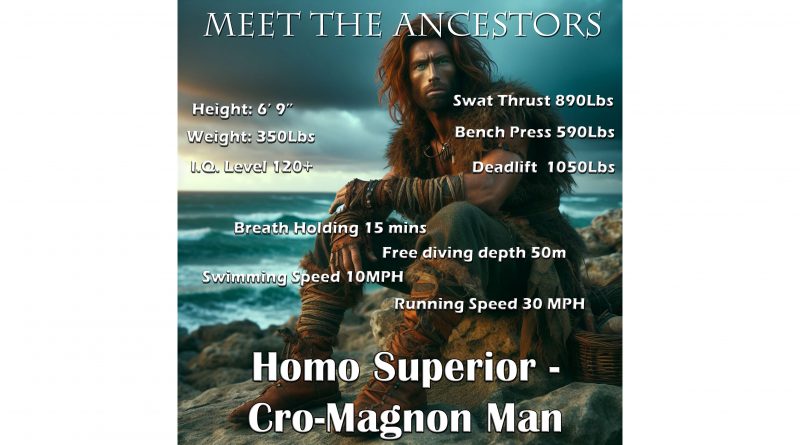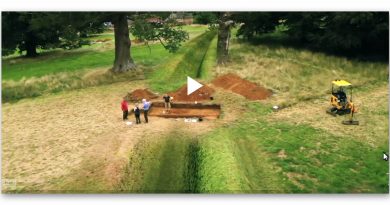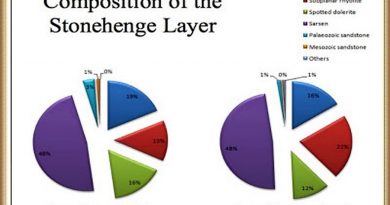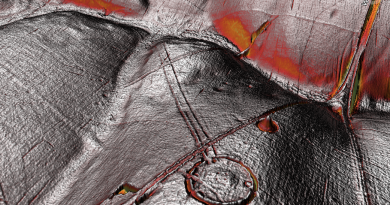Giant Skeletons (Cro-Magnon) – the forgotten species
The myths about giants go way back in history, and science fiction has taken such stories and exaggerated the truth to such proportions that many believe such tales are pseudoscience and dismiss them without proactive thought. But in the Victorian era archaeologists had no such doubts when they discovered the ‘Giant Skeletons’ of the past, they had sufficient biological proof that they named this species of the Homo family ‘Cro-Magnon’ to reflect how different they were in comparison to their discoverers. (Giant Skeletons (Cro-Magnon) – the forgotten species)
Cro-Magnon is the name of a rock shelter near Dordogne, France. Here three prehistoric skeletons were found in 1868. These humanoid remains are about 28,000 years old. These skeletons showed the same forehead, upright posture and slender skeletons as modern humans. Necklaces were found buried with their bodies, suggesting the first forms of humanoid burial rights. These bodies showed signs of illness and injury; some had fused vertebrae in their necks, and others have skull fractures showing that they had cared for each other as these skeletons showed signs of healing and, therefore, living beyond their injuries.
From Wikipedia:
Cro-Magnon is a name that has been used to describe the first early modern humans (early Homo sapiens sapiens) of the European Upper Paleolithic. Current scientific literature prefers the term European Early Modern Humans (EEMH), to the term ‘Cro-Magnon,’ which has no formal taxonomic status, as it refers neither to a species w or subspecies nor to an archaeological phase or culture. The earliest known remains of Cro-Magnon-like humans are radiocarbon dated to 43,000 years before present, being one of many subgroups of the modern humans who left Africa around 120,000 years ago, they are among the ancestors of current European populations.
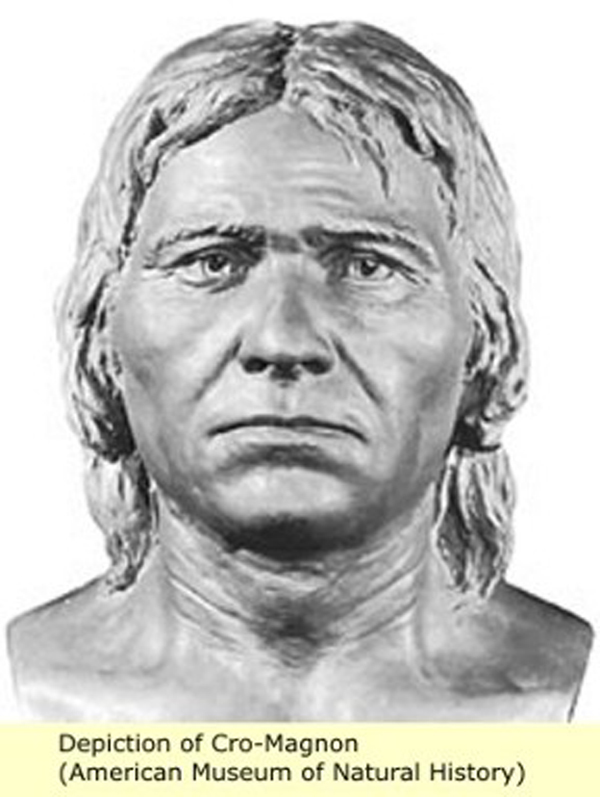
Cro-Magnons were robustly built and robust. The body was generally heavy and solid with a strong musculature. The forehead was fairly straight rather than sloping like in Neanderthals and with only slight brow ridges. The face was short and wide. Like other modern humans, Cro-Magnons had a prominent chin. The brain capacity was about 1,600 cubic centimetres (98 cu in), more significant than the average for modern humans. However, recent research suggests that the physical dimensions of the so-called ‘Cro-Magnon’ are not sufficiently different from modern humans to warrant a separate designation.
However, the Cro-Magnons found under the rock shelter were over a foot taller, twice as strong and lived longer than their discoverers. As Wikipedia states in a ‘throw away’ line, they also had a brain capacity 15% greater than the people who found them, and this is why the Victorians saw them as a sub-species of man and named them accordingly. Moreover, this civilisation was the first to paint and play musical instruments. The Victorian archaeologists have thoroughly questioned why they were found in caves as they often referred to our ancestors as ‘cavemen’ if they lived over 30,000 years ago.
This perceived ‘caveman’ analogy is not very helpful in understanding the complex societies of the past as it suggests that the entire ‘stone age’ population lived in caves.
The reality is that if this were a true statement, we would need to cut down the estimated number of humans in Europe at this time by about 70% as there would be insufficient caves to live in. Furthermore, the dangerous animal population, such as the Brown Bears, would have outnumbered the humans by about 6:1, not even taking into account the vast numbers of Wolves and Tigers, who also lived in the caves of Europe at this time, making it somewhat precarious to be a ‘caveman’!
Such blatant misinterpretations can cause the study of our prehistory endless problems. When archaeologists find human bones in caves with bite and scratch marks (from teeth), they immediately assume that these ‘cavemen’ lived in caves squalid conditions and were cannibalistic and, consequently, primitive and barbaric. In reality, these remains were more likely the dinner for either a brown bear or wild cat that roamed the forests of prehistoric Europe and were dragged into the cave.
So who are these Cro-Magnons, where did they come from, and where did they live?
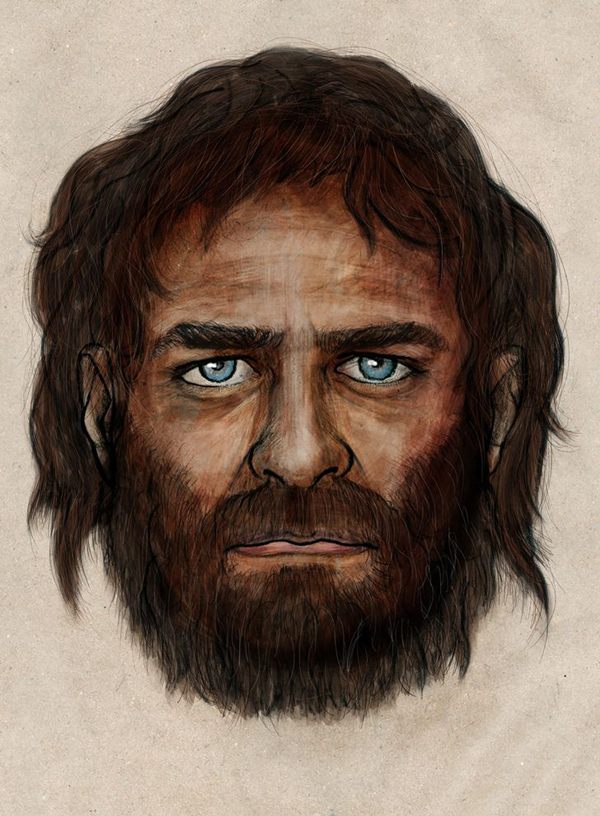
Modern news headlines often hint that our ancestry is not as ‘clear cut’ as the anthropologists would imagine. A recent article in Nature Magazine (2013) that also appeared in the tabloids showed that our DNA could be mapped to our ancient past, but the consequences led to some extraordinary conclusions as demonstrated on this National Geographic website report in Jan 2014:
Apologies to Frank Sinatra, but the authentic Ol’ Blue Eyes has been found—a 7,000year-old Spaniard whose fossil genes reveal that early Europeans sported blue eyes and dark skin.
Mapping the blue-eyed boy’s genes is part of an ongoing effort to uncover the DNA of ancient humans. The new study in the journal Nature, led by Inigo Olalde of Spain’s Institut de Biología Evolutiva in Barcelona, reports the genetic map of a skeleton found in a Spanish cave.
Why It Matters?
Scholars had suspected that blue eyes arrived as an import into Europe, brought by late-arriving farmers who invaded the continent more than 5,000 years ago. Contrary to the conventional picture of a blue-eyed, fair-haired northern European, the study suggests that blue eyes were already common among the continent’s early hunter-gatherers, along with darker skin.
However, those aren’t the only results that matter from the study. The researchers also discovered that many disease-resistance genes seen in modern Europeans were active in the ancient Spaniard’s gene map. And the study adds genetic support to archaeological findings that hint that a widespread hunter-gatherer culture cut continuously across Europe in prehistory.
The researchers extracted DNA from a tooth found with the skeleton of man, dubbed La Brana 1, uncovered in a cave near León, Spain, in 2006.
In the lab, they compared the DNA from the man with DNA from other Stone Age Europeans, such as Ötzi, the 5,300-year-old ‘Iceman’ of the Alps (whose people were farmers), and older, partial samples of genes recovered from hunter-gatherer burials in Sweden, Finland, and Siberia.
They also compared the results against the DNA of 35 modern-day Europeans.
What did They find?
Around 7,000 years ago, a Stone Age culture spread across Europe, made famous by discoveries of small, rotund ‘Venus’ figurines found in their burials. The study results suggest those people were genetically connected—one thin population of dark-haired hunter-gatherers whose domain reached from Spain to Siberia. They were also partly the ancestors of many of today’s northern Europeans.
Moreover, the ancient Spaniard had multiple genes linked to immunity, resistance to bacteria, and risks for musculoskeletal ailments, once seen in people today. Understanding the origin of these genes can help explain their function, which could aid medical studies.
The study brings some good news for fans of the ‘Paleo Diet’ and other get-back-to-nature notions, suggesting that people carry around plenty of genes leftover from their primaeval forebears. The survival of some disease-resistance genes that mattered greatly in antiquity, as shown by their continuity in modern humans, also can help show how evolution worked its magic on us and is still working today.
The conclusion was that in Spain, you had black men (dark-skinned doesn’t mean suntanned!) with blue eyes – all very nice and ‘politically correct’ until you look around to find how many black blue-eyed people are around today and become disappointed. The reality is that we have blue eyes not only in our genes but moreover, in prehistoric person’s genes.
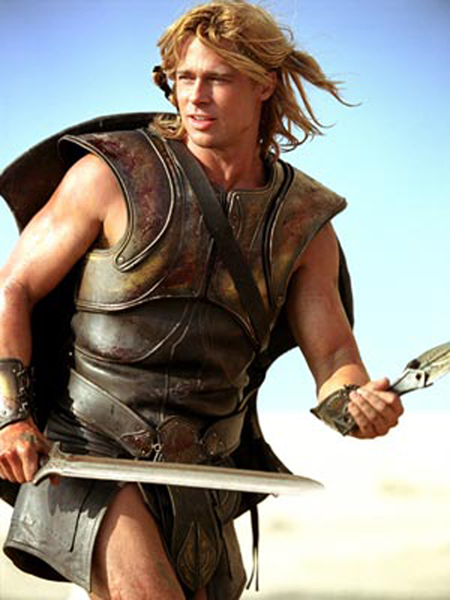
So, where do we get Blue Eyes from?
According to an epidemiologist, Mark Grant from Loyola University, Chicago, one out of every six people in the U.S. has blue eyes, making 16.6% of the entire U.S. Population. His research was published under the title, “Cohort effects in a genetically determined trait: eye colour among U.S. whites.”
Blue is the second rarest eye colour in the world after green, especially in Asian and African countries. This must be the reason why blue eyes always get lucky in grabbing people’s attention. Hollywood stars like Cameron Diaz, Nicole Kidman, Marilyn Monroe and ol’ blue eyes Frank Sinatra are all blue-eyed beauties that rule the hearts of millions. In fact, in some cultures, blue eyes and blond hair are associated with fertility in women. Companies selling colour contact lenses claim that the most popular colour for the contact lenses being sold is blue.
Now the question is; How did this Eye Colour originate?
The blue colour eyes originated because of the genetic mutation that took place way back in time, at least ten thousand years ago. According to a study published in “Human Genetics,” this miracle happened in the region near the Black Sea during the Neolithic revolution.
Wikipedia:
Blue eyes consist of low amounts of melanin within the iris stroma; longer wavelengths of light tend to be absorbed by the underlying iris pigment epithelium, and shorter wavelengths are reflected and undergo Ryleigh’s scattering.
The origin of blue eyes was traced for the first time in 2008; by a group of researchers from Copenhagen University who claimed that just one person was responsible for the blue coloured eyes of millions of people living on the planet. This means all blue-eyed people have a single common ancestor.
According to Dr Eiberg at the University, “Originally, we all had brown eyes.” Melanin is the main component responsible for the brown-black pigmentation in the iris. As discussed earlier, in blue eyes, the melanin concentration is low in the iris stroma.
What caused this low concentration of melanin?
Professor Eiberg also believes, “A genetic mutation affecting the OCA2 gene in our chromosomes resulted in the creation of a ‘switch,’ which literally ‚turned off’ the ability to produce brown eyes.”
The OCA2 gene is responsible for producing melanin, which gives colour to our skin, eyes and hair. There is a ‘switch’ located next to the OCA2 gene. In the case of blue eyes, the switch is not entirely turned off but limits the action of the OCA2 gene. This reduces the production of melanin, as a result, the brown colour of the eye is diluted to blue.
Another interesting fact is that if, in any case, this switch gets destroyed, or if it is completely turned off, your skin, hair and eyes would be without melanin. This condition is also known as ‘Albinism.’
The amount of melanin is responsible for the variation of the eye colour ranging from brown to green, but there is only a small degree of variation in the melanin of the eye in the case of blue eyes. Professor Eiberg states, “From this, we can conclude that all blue-eyed individuals are linked to the same ancestor,” he adds, “They have all inherited the same switch at exactly the same spot in their DNA.”
Professor Eiberg also compared the blue colour of the eyes of individuals living in different countries living in Denmark, Turkey and Jordan and also examined their mitochondrial DNA suggested that the genetic mutation which turns the brown eyes to be blue does not have any negative effect on the human body, he also states that “it simply shows that nature is constantly shuffling the human genome, creating a genetic cocktail of human chromosomes and trying out different changes as it does so.”
The percentage of people with blue eyes is decreasing in the U.S. over time. Factors could be an increase in immigrants from Asian countries with brown eyes and interracial relationships. The countries where you will find blue eyes most commonly are Germany, Netherlands, Scandinavia and the Baltic States. You will rarely find blue eyes in North Africa,
Southwest Asia and Southern Europe. Blue eye colour is also common among Israeli Jews. In Estonia, 99% of the population have blue eyes. In Denmark, only 11% of the population has brown eyes, and in Germany, almost 75% of the population have blue eyes.
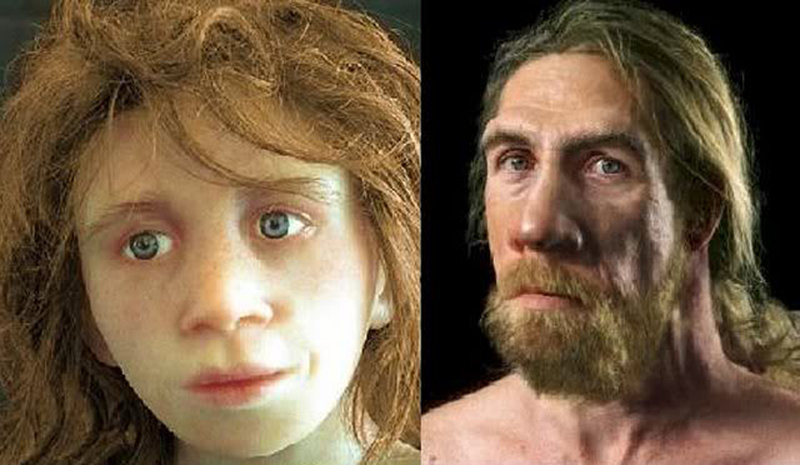
So what have ‘blues eyes’ got to do with the Cro-Magnon Giants?
Well, blue eyes are a clear sign of mutational effect in Homo sapiens – living in Estonia will not make your eyes blue if you breed solely within a brown-eyed community over 5,000 years, as the environment is not a factor in how we get blue eyes. The question we should be asking is:
Why did it happen uniquely in the Black Sea area thousands of years ago rather than millions of years?
In the two million-year-old homo history, a distant cousin of ours also had a large brain and blue eyes – it was called Homo Neanderthal.
From Wikipedia:
The Neanderthals are an extinct species of human in the genetic Homo, possibly subspecies of Homo sapiens. They are very closely related to modern humans, differing in DNA by only 0.3%, which is equal to the widest DNA gap found among contemporary humans. Remains left by Neanderthals include bones and stone tools, which are found from Western Europe to central Asia. The species is named after Neanderthal (‘Neander Valley’), the location in Germany where it was first discovered.
Neanderthals are generally classified by palaeontologists as the species Homo neanderthalensis, but a minority considered them to be subspecies of Homo sapiens, (Homo sapiens neanderthalensis). The first humans with proto-Neanderthal traits are believed to have existed in Europe as early as 600,000–350,000 years ago.
The exact date of their extinction is disputed. Fossils found in the Vindija Cave in Croatia have been dated to between 33,000 and 32,000 years old, and Neanderthal artefacts from Gorham’s Cave in Gibraltar are believed to be less than 30,000 years old, but a recent study has re-dated fossils at two Spanish sites as 45,000 years old, 10,000 years older than previously thought, and may cast doubt on recent dating of other sites. Cro-Magnon (early-modern-human) skeletal remains showing some ‘Neanderthal traits’ have been found in Lagar Velho (Portugal) and dated to 24,500 years ago, suggesting that there may have been an extensive admixture of the Cro-Magnon and Neanderthal populations in that region.
Several cultural assemblages have been linked to the Neanderthals in Europe. The earliest is the Mousterian stone tool culture, which dates to about 300,000 years ago. Late Mousterian artefacts were found in Gorham’s cave on the south-facing coast of Gibraltar. Other tool cultures associated with the Neanderthals include the Châtelperronian, the Aurignacian, and the Gravettian; their tool assemblages appear to have developed gradually within their populations, rather than being introduced by new population groups arriving in the region.
With an average cranial capacity of 1600cc, Neanderthal’s cranial capacity is known to be notably larger than the 1400cc average for all races of modern humans, indicating that their brain size was at least as large, if not larger. In 2008, a group of scientists produced a study using threedimensional computer-assisted reconstructions of Neanderthal infants based on fossils found in Russia and Syria. The study indicated that Neanderthal and modern human brains were the same size at birth, but by adulthood, the Neanderthal brain was larger than the modern human brain. They were much stronger than modern humans, having particularly strong arms and hands. Males stood 164–168 cm (65–66 in) and females about 152–156 cm (60–61 in) tall.
Genetic evidence published in 2010 suggests that Neanderthals contribute to the DNA of anatomically modern humans, probably through interbreeding between 80,000 and 50,000 years ago with the population of modern humans who had recently migrated from Africa. According to the study, by the time that population began dispersing across Eurasia, Neanderthals genes constituted as much as 1–4% of its genome (roughly equivalent to having one Neanderthal great-great-great-grandparent). Ötzi the iceman, Europe’s oldest preserved mummy, was found to possess an even higher percentage of Neanderthal ancestry. Recent findings suggest there may be even more Neanderthal genes in human, non-African genes than previously expected, at about 20% of the human genome instead.
Neanderthals had larger brains, were more robust, and 3% of our DNA comes from their genes and had similar ‘traits’ to Cro-Magnons – but that’s not all, what wiki failed to disclose is that they also had blue eyes and ginger/blond hair! So is it possible that Cro-Magnons are the Homo Sapien / Neanderthal crossbreeding product, and if so, when did this happen?

To place an exact date on when this crossbreeding began or when the first Cro-Magnon was born is impossible to suggest, but another cave discovery of a Cro-Magnon skeleton near the Iron Gates in Romania, maybe the site gives us an indication of a rough date for this occurrence. It is situated in the Danubian corridor, which may be the entry point for the Cro-Magnons into Europe from Asia. Pestera cu Oase (cave with bones) ‘Oase 1’ has a thick jawbone and other Neanderthal features, but with other Homo Sapien features showing signs of being one of the first ‘crossbreeds’ has been dated at 35,000 years ago, about the same time as humanity left Siberia (Caspian Sea) and entered Europe.
Why are Cro-Magnons not seen as a Separate Species anymore?
Before we try to answer this question, we must understand why archaeologists in the first instance believed this was a sub-species of man and hence the name Cro-Magnon giving to the remains rather than Homo Sapien.
Cro-Magnon’s skull is long-headed; the forehead is straight, the brow ridges only slightly projecting; the cranial vault is noticeably flattened, and the occipital bone (at the back of the head) projects backwards. The cranial capacity (brain) is large, about 1600cc. Although the skull is relatively long and narrow, the face appears quite short and wide. The forward projection of the upper jaw is also distinctive; the eye sockets are low-set and somewhat square, and the nasal aperture of the skull is narrow and strongly projecting.
The mandible is robust, with massive ascending ramus (the upward projection of the jaw, where it attaches to the skull), has strongly developed points of muscular attachment and quite a prominent chin. The stature of CroMagnon is very tall, on average well over six feet. Their longevity was exceptional for a prehistoric Society as some skeletons are found to be over 50 years old – this should be set in context to other ancient civilisations. The average age of a Neolithic (farmers) man was 25 and a Roman only 30.
You can see why the Victorians, with an average height of 5′ 2″ and an average age of death at 34 (44 for the academic classes and 25 for the working class) saw Cro-Magnon man as a sub-species as far apart from themselves as the Neanderthal.
An interesting fact is that there are notable differences between Eastern and Western types of Cro-Magnon man humanoids genetically mutated to create Haplogroups (a group of genes within an organism that was inherited together from a single parent) M173 and M343 about 50,000 years ago; some moved east the others moved west. The Eastern types have been given individual titles to show the variation, such as Brunn Man, Predmost or Combe Capelle.
These Eastern types of humanoid are generally shorter, more gracile and smaller brained than the western Cro-Magnon that ventured into Europe. Still, there is now a tendency to place them all under one banner called ‘modern man’, which has the effect of confusing the issue and leading to generalisations that Cro-Magnon was not as tall or larger brained as they were smaller non-Cro-Magnons have been added to bring down the average statistic. For example, the Combe Capelle Man is only 5′ 4″ rather than the French and Spanish Cro-Magnons’ six-foot statue; hence, some reference books classify Cro-Magnons incorrectly as 5′ 6″ – 5′ 7″.
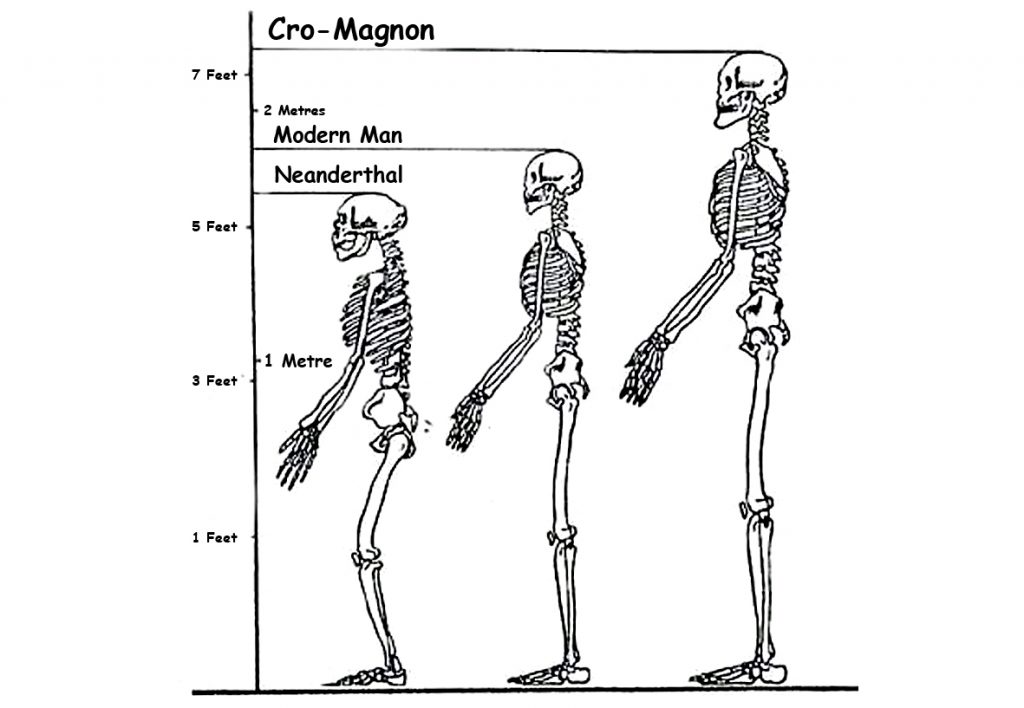
The second example of the difference between east and west Cro-Magnon is the tool kit they used; the Eastern tools are just a slight extension of the Neanderthal toolkit of the past 80,000 years, whereas the Western toolkits show signs of craftsmanship. However, the most apparent signs of the difference between the east and west Cro-Magnon’s and all other members of the human tree is that Cro-Magnons brought art and music to our civilisation. It is in the paintings found ‘throughout’ the Pyreness and Cantabrian mountains in France, which have become famous throughout the world, showing a high degree of skill and coordination of these skilled artists, which was missing in the eastern group.
Anthropologists agree that the eastern Cro-Magnons were nomads indicated by their numbers, which were extremely thin and scattered in occupational sites. While the western Cro-Magnon numbers are usually thick (meaning a long and settled occupation in a single place) and are clustered towards the rivers of the European continent, which could explain the sources of their food and the differences in their physical appearance over time and consequently, their increased intelligence.
These occupational sites also contain the first evidence of ‘houses’, which answers an earlier question in this chapter asking where did they live if not in caves – in fact; they lived in houses showing that this society was not the stereotypical ‘cave men’ archaeologists still used to describe prehistoric Europeans.
Cro-Magnons resulted from a crossbreed between migrating Sapiens from Africa and Neanderthals, and this crossbreeding took place on many occasions and locations ‘prior’ to their travels into Europe from Siberia (Caspian Sea). Consequently, how the family structure is managed is very important if this kind of crossbreeding was going to be successful, it is more likely that the Neanderthal family groups would mate with Sapien males for they are of ‘matriarch’ structure, which is reflected in their burial practices, which have shown that Neanderthals buried their dead with items and flowers long before homo sapiens burial customs were established.
It should be recognised that even in today’s societies, in the third world, infanticide is commonplace as strong independent boys are desired as they can work more hours and support the family financially better than girls who are seen as liabilities. Hunter-Gather Sapien groups would travel long distances, and for the same reason, boys would be ‘preferred’ to the social group that was probably male-dominated, leaving girls and the old when the terrain becomes difficult without assistance.
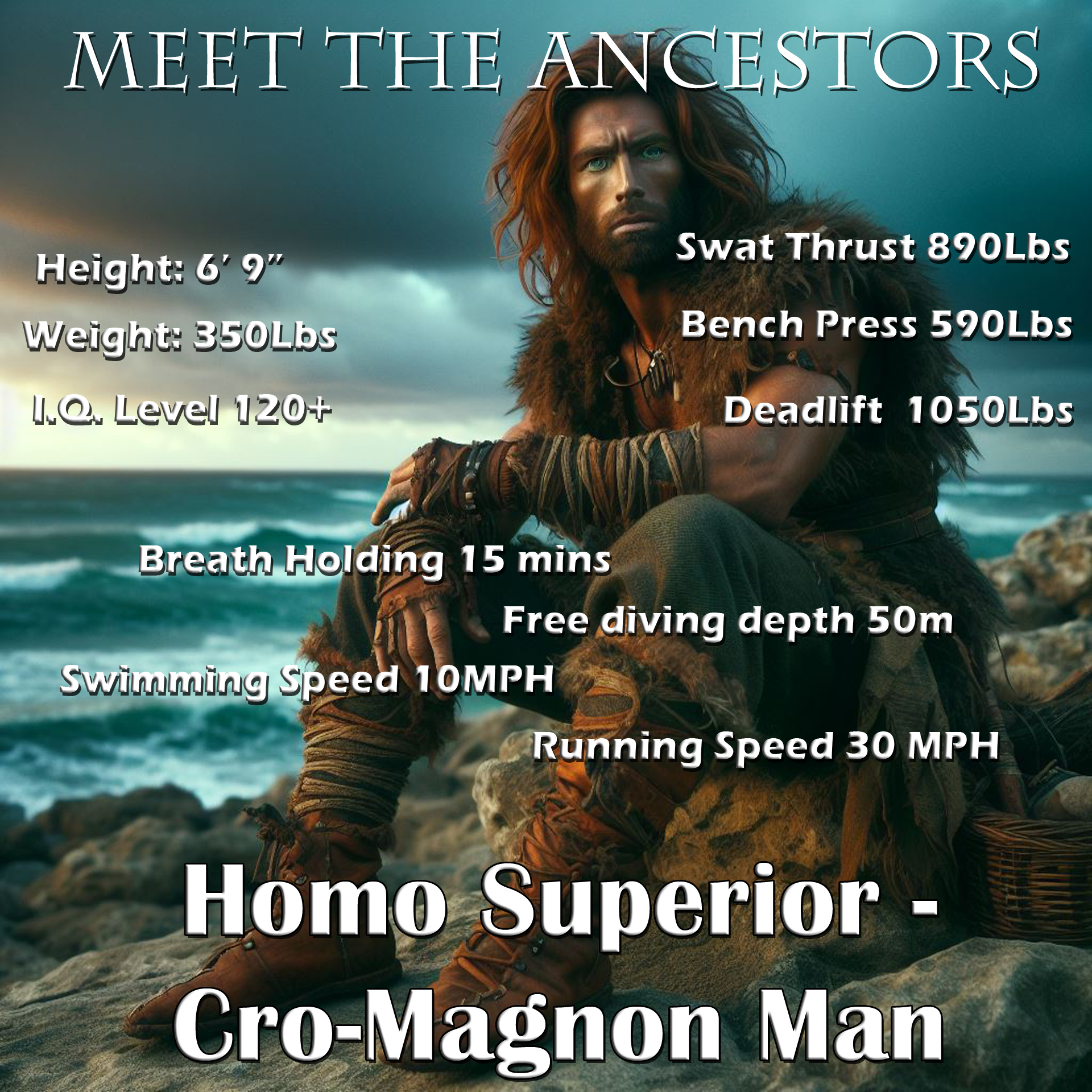
Crossbreeding
The Neanderthals had successfully survived over 100,000 years of a fluctuating climate without extinction – but then disappeared almost overnight without reason or archaeological evidence. The causation of this extinction could be relatively simple – as in the female to male ratio being too great/ small or quite possibly reintroducing of a Sapien disease, which was deadly to the Neanderthals. For example, the smallpox plagues that infested Central America after the arrival of the Spanish, who made war on the Aztecs. The war killed little compared to the Smallpox that spread North and South, killing 90% of the population who had no immunity. Such a disease during the harsh winters of the last ice age would undoubtedly end the Neanderthal species, especially when you remember the finding of Prof Eiberg earlier noting that people carrying ‘blue-eyed’ DNA in modern man carried a type of disease immunity.
So why was there crossbreeding?
Males of many species tend to ‘mate’ at random without emotional or family connection for self-fulfilment, and so the pairing would leave a Neanderthal’ single mother’ and a Cro-Magnon child who shared the positive aspects of both species. Alternatively, if the species was disappearing due to the lack of males or a selective disease, the Neanderthals may have no other option but to pair with Sapiens for pure survival.
So what are the positive attributes of this crossbreeding of the Species?
Neanderthals used simple stones for tools. They constructed and made essentially the same stone tools repeatedly for perhaps 200,000 years, until around 35,000 years ago, with slight variation or consideration of alternatives. They greatly lacked creativity, initiative or imagination, and tended to create simple stone tools that served a single purpose, even with a larger brain than modern man.
As neatly summed up by an ardent defender of Neanderthal cognitive capabilities (Hayden, 1993, p. 139).
“As a rule, there is no evidence of private ownership or food storage, no evidence for the use of economic resources for status or political competition, no elaborate burials, no ornaments or other status displays items, no skin garments requiring intensive labour to produce, no tools requiring high-energy investments, no intensive regional exchange for rare items like seashells or amber, no competition for labour to produce economic surpluses and no corporate art or labour intensive rituals in deep cave recesses to impress onlookers and help attract labour.”

Neanderthals tended to live in the ‘here and now’ with limited ability to think about or consider the distant future, the only notable exception being the future life after death. This noteworthy exception is a function of the differential evolution of the head-on versus the temporal lobes. The head-on lobes are the ‘organisational and management of the brain and are responsible for the initiative, goal formation, long-term planning, the generation of multiple alternatives, and the consideration of numerous alternative consequences. The frontal lobes are the source of creativity and imagination, whereas the temporal lobes are the brain’s ‘speech and vision centre. The temporal lobes were maximally developed in Neanderthals, whereas the frontal lobe would increase in size by a third in the transition from archaic humans to Cro-Magnon woman or man.
Based on a gross analysis of the skull and casts made of the skull’s inner surface, it is apparent that Neanderthal men and women possessed a well-developed inferior temporal lobe, whereas the frontal lobe is sloped and stunted. The temporal lobes and the limbic structures buried within are directly implicated in the generation of personal, emotional, and religious experience, including the ability to form long-term emotional attachments and feel intense love. This fierce love plays an essential role in the nurturing power of the less mobile Neanderthal groups, less likely to abandon their ‘crossbreed’ babies, unlike the more mobile ‘nomad’ Homo Sapien groups.

Neanderthals provided loving care for friends and family who had been injured or maimed, enabling them to prolong their lives despite their grievous injuries. For example, the skeleton of one Neanderthal male, approximately aged 45 when he died, had been cared for several years following profoundly crippling injuries. His right arm had wasted away through disease or injury, and his lower arm and hand had apparently been ripped or bitten off, and his left eye socket, right shoulder, collarbone, and both legs were severely injured. Someone loved and tenderly cared for this man. He was no doubt a father, a husband, a brother, and a son, and someone in his family not only provided long term loving care to make him comfortable in this life but prepared him for the next life as well.
Moreover, Neanderthals could not fashion complex tools or think complex thoughts, as they lacked the ‘complex’ language, although they could communicate on a fundamental level. However, they were people of passion who experienced profound emotions and love, made possible by the limbic system and temporal lobe. It is because they had the limbic capacity to experience love, spiritual awe, and religious concerns that these expressions of love may have continued beyond death. Hence, the Neanderthals carefully buried their dead, providing them with food and even sprinkling the bodies with seven different types of blooming fragrant flowers.
In comparison, their ‘crossbreed’ offspring were intellectual giants; they had a brain capacity more significant than both mum and dad, inheriting the Neanderthal’s visual cortex and strength/weight with the Sapiens frontal cortex and height/mobility. Cro-Magnons were accomplished artists, musicians, craftsmen, sorcerers, and highly talented hunters, fishermen, and highly efficient gatherers and herbalists. When they emerged upon the scene over 35,000 years ago, they carried and fashioned tools and weapons that had never been seen before. They had the know-how to make and bake pottery to construct clay figurines and bake bread by building kilns and burning coal to fire and mould their minds’ creations.
As Jacob Bronowski observed in his book and T.V. series ‘The Ascent of Man’ 1973. “From an early time man made tools by working the stone. Sometimes the stone had a natural grain, sometimes the toolmaker created the lines of cleavage by learning how to strike the stone. It may be the idea comes, in the first place, from splitting wood, because wood is a material with a visible structure which opens easily along the grain, but which is hard to shear across that grain. And from that simple beginning man, prizes open the Nature of things and uncover the laws that the structure dictates and reveals. Now the hand no longer imposes itself on the shape of things. Instead, it becomes an instrument of discovery and pleasure together, in which the tool transcends its immediate use and enters into and reveals the qualities and forms that lie hidden in the material. Like a man cutting a crystal, we find in the form within the secret laws of Nature.”

But this ‘new thinking’ and relationships run far deeper than the simple tools; they were remoulding and discovering, for Bronowski found a ‘direct link’ between art, structure, creativity and society. In reality, these elements show us that this society was ‘well structured’ probably with an established hierarchy system. Humans join into families, and families join into kinship groups, the kinship groups into clans or tribes, and finally, the tribes into nations or civilisations.
From the time of Homo Erectus (1.9 million to 500,000 years ago), humans had utilised fire to keep warm, provide light, cook their food, and ward off animals. However, the Cro-Magnon learned over 30,000 years ago how to make fire using the Firestone; iron pyrite was repeatedly struck with a flint, causing sparks, which could easily ignite brush. They also created the first rudimentary blast furnaces capable of emitting enormous amounts of heat to fire clay. This was accomplished by digging a tiny tunnel into the bottom of the hearth, which allowed air to be drawn in. Indeed, 30,000 years ago, these people were making fire-hardened ceramics and clay figures of animals and females with bulging buttocks and breasts, presumed to be the first goddesses or just the first ‘impressionist’ art form.
Much of the art produced, be it finely crafted ‘laurel leafs’ or other artistic masterpieces, served ritual, spiritual, and aesthetic functions. However, they also created art that was meant to be looked at, owned and admired, and for trade, jewellery and household decorations, and as highly prized possessions or possibly religious reverence. Likewise, the first musical instruments were created by these people some 25,000 years ago. These included wooden drums, tiny flutes and whistles.
These people were also the first to weave baskets and the first to use ‘needle and thread’ to make finely fitted clothes carefully and deftly sewn together. Unlike all those who had come before them, they decorated their clothes, tools, and weapons with elaborate designs and geometric and animal symbols. Within their underground ‘cathedrals’ (using the stone structure of the cave system as we use stone in our past religious buildings), they left behind elaborate and complex paintings, some of which were dark, mysterious and almost 3-dimensional. These people demonstrated an aesthetic, artistic awareness and mastery that were unprecedented and equal to the ability of any living artist today.
Thirty-five thousand five thousand years ago, Cro-Magnon was painting animals not only on walls but on ceilings, utilising rich yellows, reds, and browns in their paintings and employing the actual shape of the cave walls to conform with and give life-like dimensions, including the illusion of movement to the creature they were depicting. Many of their engravings on bones and stones also show a complete mastery of geometric awareness, and they often used the natural contours of the cave walls, including protuberances, to create a 3-dimensional effect.
The drawing or carving often became a harmonious or organic part of the object, wall, ceiling, or tool upon which it was depicted. The Cro-Magnon drew and painted scenes in which animals mated, defecated, fought, charged, and/or were fleeing and dying from wounds inflicted by hunters. The Cro-Magnon cave painters were exceedingly adept at recreating the scenes of everyday life. Moreover, most of the animals were drawn to scale; that is, they were depicted in their actual size, and all this, 35,000 years ago.
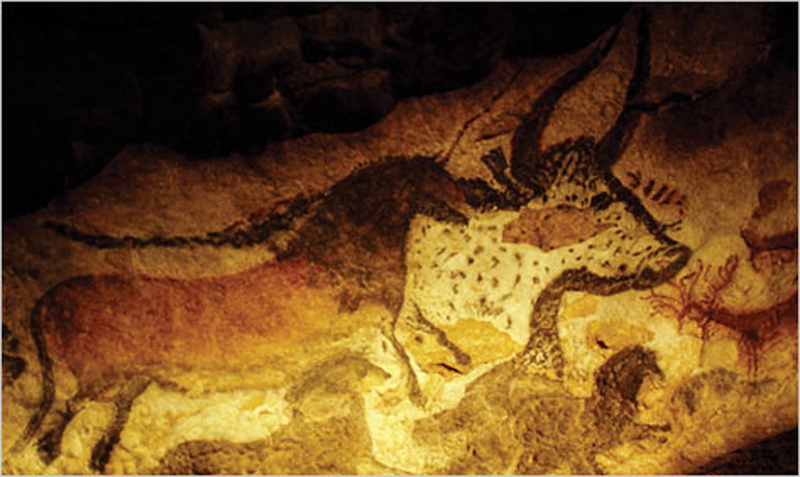
“Here I can only give you may personal view” Jacob Bronowski (The Ascent of Man, 1973, BBC) “I think that the power that we see expressed here for the first time is the power of anticipation: the forward-looking imagination. In these paintings, the hunter was made familiar with dangers he knew he had to face but had no come. When the hunter was brought here into the secret dark, and the light was suddenly flashed on the pictures, he saw the bison as he would face him, he saw the running deer, he saw the turning boar. And he felt alone with them as he would in the hunt. The moment of fear was made present to him; his spear arm flexed with an experience he would have and needed not to be afraid of. The painter had frozen the moment of fear, and the hunter entered it through the painting as if though an air-lock.”
The Cro-Magnons were inventive and obtained their colours from natural earth pigments, such as ocher, a clay that contains a variety of iron minerals. However, whereas Neanderthals had a fondness for red, the Cro-Magnon learned to separate and mix these pigments, creating various hues and colours. To mix and to arrive at the correct consistency, a variety of lubricants were employed, such as blood, urine, vegetable and fruit juices, animal fat, and the contents of eggs. The separate colours were then mixed in various hollowed-out rocks and shells. The Cro-Magnon artist used a brush, as well as his or her fingers in order to paint. In fact, they used a variety of different brushes, which enabled the artist to create different shades and strokes. In some cases, the artist simply blew the paint onto the drawing via a tubular bone, making a mist-like spray.
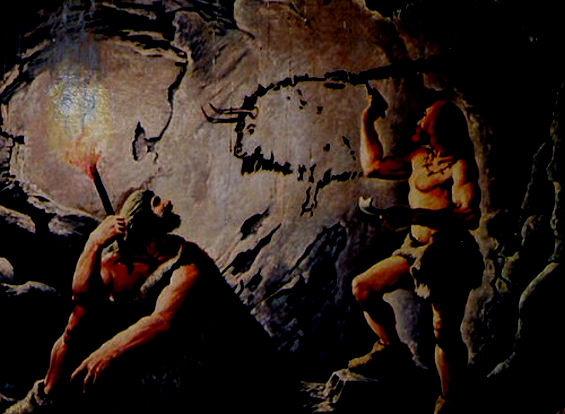
Cro-Magnon artists had also invented abstract impressionism, as many of their paintings and artworks were exceedingly abstract, surrealistic, or comprised of geometric forms and concentric shapes and ovals, which in some cases formed abstract versions of animals or women. Indeed, they displayed an artistic mastery equal to that of any modern master, including Picasso. Awestruck by these Cro-Magnon masterpieces’ Picasso once complained that in 30,000 years, “we have learned nothing new. We have invented nothing.” Indeed, the geometric and angular form of representation employed by these pre-Atlantis Masters repeatedly appears throughout history and is found in Egyptian, Sumerian, and even early Greek art.
So to lose this unique species to the ‘politically correct’ anthropologists is not only complete madness but scientifically inaccurate. Cro-Magnons are the forefathers of our culture and humanity. It would be lovely if a sole pair of humanoids (Adam & Eve) created all the diverse cultures of humanity, but that is delusional. Mankind has evolved by mutation into groups of different humanoids, which Darwinian Theory is all about – mutation, not adaption!
Cro-Magnons are the ‘mutational’ group of the crossbreeding of humans and Neanderthals; these sub-species possessed blond/red hair and blue/green eyes. They were the prehistoric giants of Victorian’s archaeology are alive and well in our ‘modern world’ for we see them nearly every day of our lives count the numbers of these ‘mutations’, you find on the Bus, Tube or on Television.
For further information on Cro-Magnons click HERE or visit our video channel HERE.

